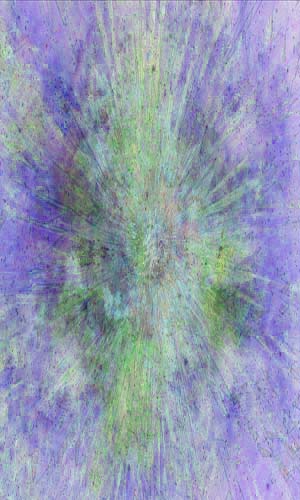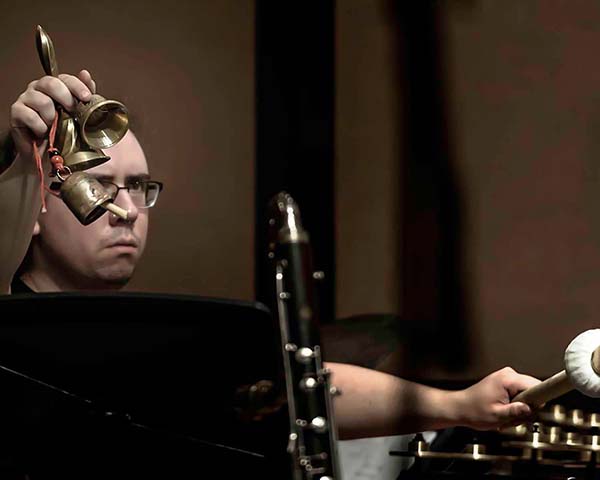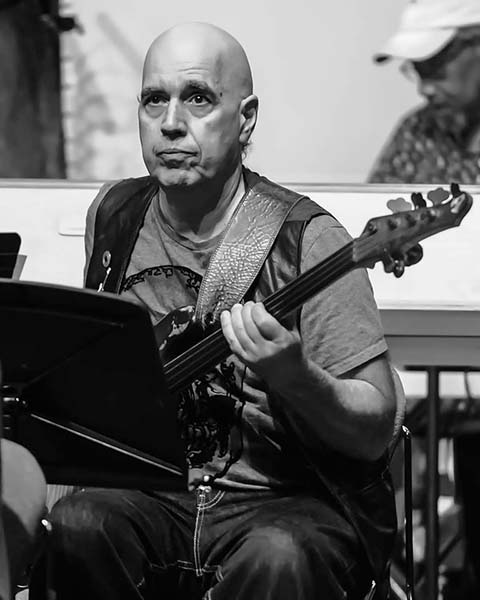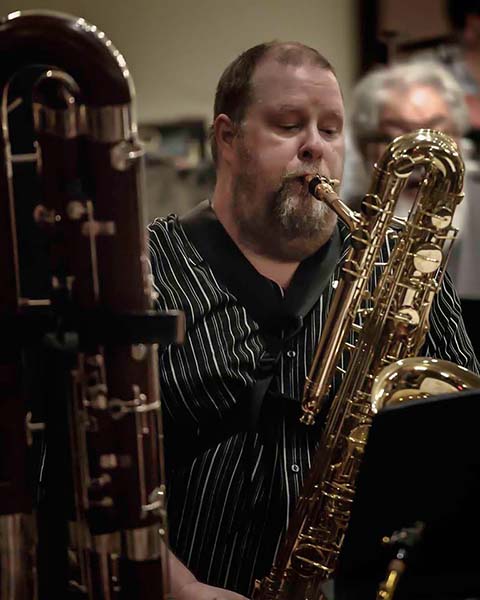Leap of Faith Orchestra
Graphic Scores by PEK
Cosmological Horizons
Excerpt from Karl Ackermann Review
“… For several years PEK has utilized his Frame Notation technique where the score is seen in written descriptions and archetypal symbols within duration bars. This allows the musicians to immediately sight their cues as well as providing a view of the larger scope of the piece. To see the score laid out in hard-copy form is to witness a cross between visual art, Gantt charts and complex schematics.…”
Karl Ackermann – AllAboutJazz


Excerpt from Nick Ostrum Review
“… although the overall effect is compelling enough, repeated listens uncover the mechanics, the discrete explorations of timbre and tone, the interlocking and interdependent musical gears that are turning at each moment. A single, intricate track recorded live at Killian Hall (MIT), this really is an opus, and one well worth checking out…”
Nick Ostrum, SquidsEar
Excerpt from Contemporary Fusion Review
“…After forty years (+) of reviewing music, both “straight-up” and “out there“, I can truly say that the music from LOFO is different than anything I’ve ever listened to… …if you claim to be a fan of adventurous improvised music, this album (and their entire series, in fact) MUST be in your collection – it’s some of the best creative energy I’ve ever heard, and that’s saying a lot, because I’ve not only listened to a lot of such, but did (in fact) perform some of my own madness back in the day! …”
Rotcod Zzaj, Contemporary Fusion


The largest ensemble of Boston-area David M. Peck’s Leap of Faith collective using Peck’s frame notation compositional method of written descriptions and graphic symbols to allow large ensembles to create major works without extensive rehearsing, accompanied by a 23 page booklet that illustrates that concept and details this 2018 Killian Hall, MIT, concert
Squidco Staff
Excerpt From Liner Notes by PEK
“… These scores are very special compositions intended to solve a very tricky problem of composition for large improvisation ensembles: How do you rehearse complex works for large ensembles when all of the participants are extremely busy? Answer: Compose works that do not need to be rehearsed. The scores use a device call Frame Notation where written English descriptions of the overall sonority desired and simple graphic symbols are given durations on a timeline for each player indicating when and how to play and when not to play…”





Cosmological Horizons:
Leap of Faith Orchestra
Killian Hall, MIT, Cambridge MA – 14 July 2018
1) Leap of Faith Orchestra –
Cosmological Horizons – 1:17:20
PEK – clarinets, saxophones, double reeds, sheng, harmonium +
Glynis Lomon – cello, aquasonic, voice +
Yuri Zbitnov – drums, lead gong, brontosaurus bell, percussion +
Jim Warshauer – clarinets, saxophones +
Zach Bartolomei – clarinets, saxophones +
Charlie Kohlhase – saxophones +
Bob Moores – trumpet +
Eric Dahlman – trumpet, overtone voice +
Forbes Graham – trumpet +
Duane Reed – baritone horn, bass trombone +
Dave Harris – trombone, tuba
Mimi Rabson – violin +
Elinor Speirs – violin +
Jane Wang – cello +
Silvain Castellano – double bass +
Zachary Levine – double bass +
Albey onBass – fretless electric bass +
Eric Woods – analog synth, mandolin +
Chris Florio – guitar synth +
Reverend Grant Beale – guitar, wood +
Eric Zinman – piano +
Silvain Castellano – bass +
Syd Smart – electronic drums, gong, percussion +
Eric Rosenthal – drums, gong, percussion +
Steve Niemitz – gong, percussion +
(+) wood, metal, aquasonic, slide whistle, rachet, flex-a-tone, vuvuzela, melodica etc.
2) Leap of Faith –
Boundaries (download bonus track) – 20:55
PEK – clarinets, saxophones, double reeds, sheng, harmonium +
Glynis Lomon – cello, aquasonic, voice +
Yuri Zbitnov – drums, lead gong, brontosaurus bell, percussion +
Mimi Rabson – violin +
Elinor Speirs – violin +
Jim Warshauer – clarinets, saxophones +
Syd Smart – electronic drums, gong, percussion +
Eric Rosenthal – drums, gong, percussion +
Steve Niemitz – gong, percussion +
(+) wood, metal, aquasonic, slide whistle, rachet, flex-a-tone, vuvuzela, melodica etc.
Full Set Videos
Video Shorties
Click on Image Below
to View pdf of the Full Score

Click on Image Below
to View pdf of the Full Program





Karl Ackermann Review, All About Jazz
David M. Peck’s (PEK) Leap of Faith collective is brought together in its largest formation of twenty-four musicians for a marathon performance of the leader’s Cosmological Horizons composition. This second of two annual performances of an orchestra culled from the Evil Clown label’s various groups (String Theory, Mekaniks, Metal Chaos Ensemble, etc.) was held in Killian Hall on the Boston campus of MIT.
As he often does, PEK composes a single, extended piece for the duration of the performance; the title track here clocking a bit over seventy-seven minutes. For several years PEK has utilized his Frame Notation technique where the score is seen in written descriptions and archetypal symbols within duration bars. This allows the musicians to immediately sight their cues as well as providing a view of the larger scope of the piece. To see the score laid out in hard-copy form is to witness a cross between visual art, Gantt charts and complex schematics. Somehow, PEK makes it all work cohesively.
“Cosmological Horizons” opens in a sea of tranquility but that stop is brief. A gong, and gently ringing bells, are joined first by sharp percussive effects, then strings. Reeds and horns build in layers, along with an assortment of PEK’s favorite non-instruments. Somewhere around the halfway mark it feels like everything comes together—not in harmony—but in something much closer to approaching chaos. Eric Zinman’s piano temporarily re-grounds the ensemble only to have the larger group thunder back with a disembodied ferocity. The construction of PEK’s compositions offer few predictable rudiments in the structure of the composition; melodies appear as transitory moments of discovery, barely audible through the collective improvisation. It is experimental, and abstract, and certainly aimed at the open-minded listener.
Cosmological Horizons is also available digitally and includes an additional twenty-one minute track—”Boundaries”—performed by a sub-set of the full orchestra. PEK’s Evil Clown label has also undergone an artistic makeover in the packaging of it’s releases. Beyond eliminating the jewel case, Cosmological Horizons includes a twenty-three page insert that illustrates the Frame Notation, coding of instrument groups and score. It’s a colorful, informative and entertaining visual to accompany the music.
Karl Ackermann – AllAboutJazz

Nick Ostrum Review, Squid’s Ear
Something interesting is brewing in greater Boston and much of it seems to revolve around the tireless multi-instrumentalist David Peck (PEK) and the various projects documented on his Evil Clown label. The Leap of Faith Orchestra is PEK’s largest ensemble and the raison d’etre of the smaller working units. As per the liner notes, “All of the other contemporaneous Evil Clown performances and recordings by all of the ensembles — Leap of Faith, String Theory, Mekaniks, Metal Chaos Ensemble and the Sub-Units — are preparation for these full Leap of Faith Orchestra performances.” The Orchestra consists of twenty-five members, some of whom (Glynis Lomon, Yuri Zbitnov, Eric Zinman, PEK) have been playing together in different ensembles for over 20 years. Their instruments range from reeds and brass to strings, percussions, and electronics. Fittingly, the result is something that is highly improvised, yet rehearsed; contained, yet grand.
Having listened to a lot of large ensemble music of this sort, I have always been curious about organization and dynamics. How does one design such an orchestra? By what mechanisms do composers and leaders guide the band to a common direction? Or, is this simply left up to the ebbs and flows of the performance or the whims and intentions of the performers? PEK gives detailed insight into these questions in the accompanying booklet, which explains his compositional techniques and includes copies of the score, complete with a glossary and instrumental section by section break down. (This alone makes the disc itself much more worthwhile than the download. That is, if the materiality of the object and the unique packaging — as usual designed by PEK himself — were not enough.)
Cosmological Horizons begins with a gong and mystical chimes. The rest of the band fades in unevenly, as if each section is being jostled out of one private trance and into another, more active communal one. What follows is 85-minutes of controlled chaos. The piece sounds largely free, though its contours are thoughtfully composed. This is apparent not only in the surprisingly tight sectional outbursts, but the numerous instances where the band collectively quiets to make space for brief cello, bass, piano, and other miscellaneous interludes. The percussion adds foundation and texture, with an understated dynamism. The horns are numerous, but they never fall into the free blowing competition that consume so many avant-garde big bands. The strings appear and disappear as if carried by an unsteady breeze. The electronics rarely come to the fore but offer further depth to the otherwise primarily acoustic ensemble. In other words, there is a lot going on. And although the overall effect is compelling enough, repeated listens uncover the mechanics, the discrete explorations of timbre and tone, the interlocking and interdependent musical gears that are turning at each moment. A single, intricate track recorded live at Killian Hall (MIT), this really is an opus, and one well worth checking out.
Nick Ostrum, SquidsEar



Rich sonorous frame notation improvisation Leap Of Faith Orchestra – COSMOLOGICAL HORIZONS: After forty years (+) of reviewing music, both “straight-up” and “out there“, I can truly say that the music from LOFO is different than anything I’ve ever listened to… I first reviewed their “Super Clusters” in the spring of 2018, and gave them ultra-high marks for their creative juice… on the new release, they take things even further into the “strange-o-sphere” with PEK’s “frame notations scores” as a sort of map to the outer limits, if you will… there is only one way to review such music – at FIRST LISTEN, because otherwise, it won’t be a “real” review… rather, it will be full of cliches and “considered opinions” that have nothing to do with the high splendor they are squeezing out of the notes for your sonic adventure… ergo, before you read the rest of this review, find a room where you can listen to (and watch) the entire hour and seventeen minute performance in the video they recorded for the piece…
…if you claim to be a fan of adventurous improvised music, this album (and their entire series, in fact) MUST be in your collection – it’s some of the best creative energy I’ve ever heard, and that’s saying a lot, because I’ve not only listened to a lot of such, but did (in fact) perform some of my own madness back in the day! Since you’re there already, be sure to SUBSCRIBE to PEK’s YouTube channel, too… some really great videos there! The player list is there, too.
What’s very impressive for me (since I’m a keyboard player) is the piano work that seems most prevalent at around the 21:00 minute mark… of course, you’ll want to be listening/watching with your headphones on, or you’ll miss some of the amazing creations achieved here… if you haven’t realized it yet – I am a dedicated fan of this kind of music… and LOFO is my favorite, to be sure!
In addition to the YouTube channel indicated above, you will want to check some of their other locations to stay current… their Evil Clown website; the page for Cosmological Horizons on that site; the Evil Clown Facebook page; and their BandCamp page. Don’t hesitate to jump off into the void… this band gets a MOST HIGHLY RECOMMENDED from me, with a (perfect) “EQ” (energy quotient) rating of 5.00; which means they also get my “PICK” for “best guided improvisation”
By Dick Metcalf, editor, Contemporary Fusion Reviews – August 27, 2018

Review by Bruce Lee Gallanter, Downtown Music Gallery
LEAP OF FAITH ORCHESTRA With PEK / GLYNIS LOMON / YURI ZBITNOV / JANE WANG / ERIC ZINMAN / SYD SMART / et al – Cosmological Horizons (Evil Clown 9183; USA) This is the 10th disc from the Leap of Faith Orchestra, Dave PEK’s ongoing large ensemble that only plays a couple of times per year, just on rare occasions. This is a 24 member version and it was recorded at Killian Hall at MIT in June of 2018. Throughout the rest of the year, Mr. Peck , organizes different versions of Leap of Faith, as well as several offshoot projects like the Metal Chaos Ensemble, String Theory and Turbulence. Mr. Peck records his many projects frequently both live in the Boston area, as well as at home, in the Evil Headquarters Studio. There are than 100 discs of recordings made over the past decade. Whereas practically everything performed & recorded by Leap Of Faith & the offshoots is improvised, Mr. PEK spends several months preparing for his orchestra concerts. A thorough explanation of the score is explained in the extensive liner notes, as well as pictures of the scores and musicians involved. Unlike earlier Evil Clown discs (which are CD-R’s), this one is a real CD in a lovely digipak with a thick booklet. Most impressive on many levels. As someone who genuinely appreciates large ensemble/big band music, I am awed by how much work Mr. Peck has put into this serious piece. The piece starts off somewhat chaotically, yet somehow there sounds like certain subgroups are being directed. Chattering reeds & horns, seesawing strings, layers of percussion erupting, colliding and interwoven thoughtfully, explosive Cecil Taylor-like piano… Considering how many musicians are involved here (24 by my count), it is amazing at how focused, engaging and thoughtfully balanced this is. No one really solos at length although there are bursts of well-placed solo bits: synth, piano, assorted reeds, double reeds & brass, strings and a plethora of percussion. Mr. Peck has also mastered the art of recording so that we can hear the entire orchestra clearly throughout, no easy feat. It is actually hard to believe that this is so a large an ensemble since certain sections are actually sparse in part. An outstanding effort on all fronts so grab your copy today.
Bruce Lee Gallanter, Downtown Music Gallery



Liner Notes by PEK
Twice a year Evil Clown presents the Full Leap of Faith Orchestra in its largest configuration performing a Frame Notation Score by PEK which guides the improvisation… Cosmological Horizons is being presented in a wonderful room at MIT called Killian Hall. Killian Hall is a wonderful room with high ceilings, a great grand piano and a nice live sound. Leap of Faith used this room as a recording studio for a weekend in 1997 to record Leap of Faith – Linear Combinations & Transformations and as a concert venue in 2001 for the Leap of Faith vs the Fringe Concert. Although it being a great room, it is hard to book since it is generally in use during the MIT school year.
So far we have performed 4 of my Frame Notation scores since 2015: The Expanding Universe, Supernovae, Possible Universes and SuperClusters. I am giving all of my Frame Notation compositions for the LOFO astronomical titles – It seems fitting with the scale of these events and fits well with my usual Leap of Faith / Evil Clown titles which largely draw on Scientific and Mathematical ideas. These very special full orchestra events occur only once or twice a year. For each performance I prepare a score specifically for that event which is simultaneously a Density and Sonority map prescribing the improvised development of the work.
These scores are very special compositions intended to solve a very tricky problem of composition for large improvisation ensembles: How do you rehearse complex works for large ensembles when all of the participants are extremely busy? Answer: Compose works that do not need to be rehearsed. The scores use a device call Frame Notation where written English descriptions of the overall sonority desired and simple graphic symbols are given durations on a timeline for each player indicating when and how to play and when not to play. The directions are put in little boxes called frames which are simple enough to be immediately understood by the performers. The players track the elapsed time on a very large sports clock. There is no melodic, harmonic or rhythmic information specified.
This system allows me to compose detailed Events without having to notate pitches or rhythms which would require significant rehearsal to accurately achieve. Skilled improvisers, like the ones I have recruited, can easily follow these instructions to create a highly structured improvisation without the need for specific rehearsal even when the ensemble is quite large as it is here. This allows enormous freedom and decision making for each performer and means that we do not have to rehearse these pieces prior to performance. We rely on all of the work of the overall Evil Clown project to tighten the ensembles’ improvisation across its many cross sections while the score provides directions on timing, sonority and transformation.
Each of the scores has continued to utilize the compositional symbols and devices of the previous scores while adding something new to my notational system. Some examples are large texture blocks with much of the ensemble playing auxiliary instruments (like wood or metal texture), using the decay from large gongs as structural divisions of the work to pivot into a new sonority, group action frames assigned to named groups in the ensemble, and changing the scale of the score so each page covers less time on the timeline and therefore can express more detailed events. The events have therefore become shorter on each score, thereby significantly increasing the rate of transformation.
For SuperClusters, I realized that there is no reason why the musicians cannot pay attention to the second position of the sports clock when tracking the time. It is just as easy to trigger an event at 2:17 as it is on a nice round number like 2:30. The difficulty is in clearly expressing the directions with the notation. The solution is to change the scale of the score to one minute width per page – the parts will have two systems on each page with the lower system repeated at the top of the next page to assist with page turns. I have used this scale for the opening and conclusion sections of SuperClusters, and used the 3 minutes per page with 2 minute overlap scale from Possible Universes for the balance of the work (the first two scores used a scale of 5 minutes per page with 2 minute overlap).
For Cosmological Horizons I used the one minute width for 5 sections of the work and developed several new notational devices to specify rapidly transforming sonority. I also added about 20 new group action frames to give many more gestural shapes for the Action Groups to perform. In general, as we have performed these compositions it has become clear that the frame notation is very effective and the ensemble is perfectly capable of executing even very short durations on the timeline. As such, each time I have increased the rate of and the number of transformations in the score. The audience will experience a steady flow of distinct sonorities over the duration of the performance.
All of the other contemporaneous Evil Clown performances and recordings by all of the ensembles – Leap of Faith, String Theory, Mekaniks, Metal Chaos Ensemble and the Sub-Units – are preparation for these full Leap of Faith Orchestra performances. The performances by these smaller ensembles stand by themselves as improvisation performances as well as getting us ready to improvise in a full orchestra setting. Please look for our regular concerts at Outpost 186 and Third Life Studios. Sign up for the mailing list at the Merch Table or send me email at Sparkles@GiantEvilClown.com!!
– PEK, 6/30/2018
Rob Miller Photos























